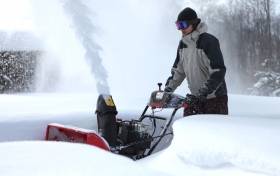Don’t Blow It: Use Your Snow Blower Safely
The sound of the plow scraping its way down the road wakes you on a wintry morning. You prepare to dig out from last night’s snow, thankful for the snow blower in the garage. But while a snow blower or snow thrower can make quick work of clearing your driveway and sidewalk, it is not without its share of danger if used improperly. Here are some important snow blower safety considerations for the next storm.
Before the Storm
Before it snows, remove any objects from your driveway that might get damaged by the snow blower or might become projectiles if thrown by the blower, such as rocks. If your snow blower is gas-powered, make sure you have enough fuel. Store and transport all fuels in approved containers.
It is also a good idea to test your snow blower to ensure it is in good working order and to have replacement parts on hand, as they can be difficult to obtain in the middle of a winter storm. Only use proper replacement parts such as shear pins, for example, which are designed to break if the snow blower jams, thus preventing further damage to your machine.
While Clearing Snow
Always start your snow blower outside, never in the garage, in case of fire, explosion or carbon monoxide (CO) poisoning. During the clearing process, wear bright or reflective clothing and be aware of traffic, especially near the end of your driveway. You also may want to wear protective eyewear.
Should your machine get jammed, never put your hand in the auger―the snow blower retains stored energy, even after it has been turned off, and the auger could start moving automatically once the jam has cleared. Depending on the object, use a shovel or rake handle to clear the blockage. Also, do not override interlocks or any other features.
If you have an electric-powered snow thrower, choose your path wisely to keep the cord safe. You will want to work away from the cord. Always use extension cords intended for outside use and equipped with a grounding prong. Plug them into a ground-fault circuit interrupter (GFCI) to help protect against shock hazards.
If you have a gas-powered snow blower, shut it down and allow it to cool before refueling. Gasoline can ignite if spilled on hot engine parts. Never try to refuel a snow blower while it is running.
Storing Your Snow Blower
Your snow blower’s temperature rises significantly while it is clearing snow. After using the snow blower, give it a chance to cool down before putting it away. To prevent a fire, avoid letting any still-hot parts of your snow blower come into contact with combustibles in your garage.
Recent Posts
How to Identify and Help Remove an Ice Dam
Sometimes, even your best efforts to prevent an...How to Help Prepare Your Boat for Spring
Are you one of the millions of boaters with spr...Space Heater Safety Tips
In order to save money in the colder months, ma...Umbrella Insurance Coverage
Umbrella insurance provides extra liability cov...5 Tips to Protect Your Possessions with Valuable Items Insurance Coverage
You may think that a homeowners insurance polic...

